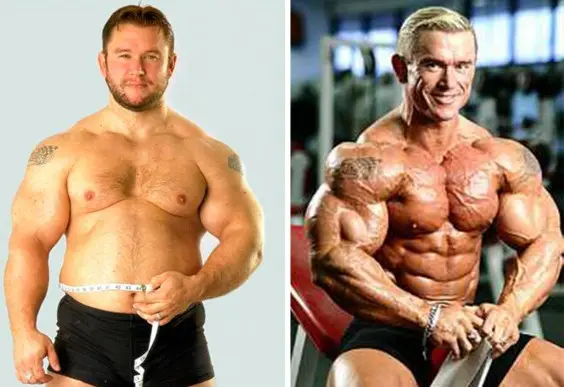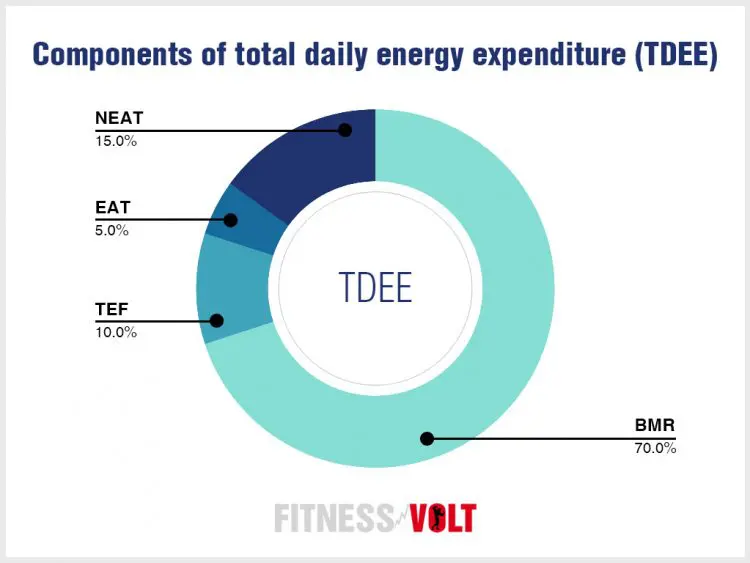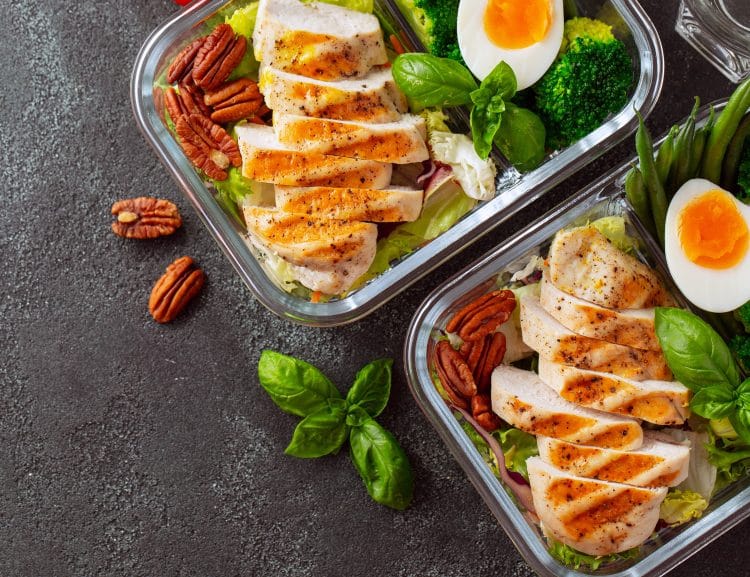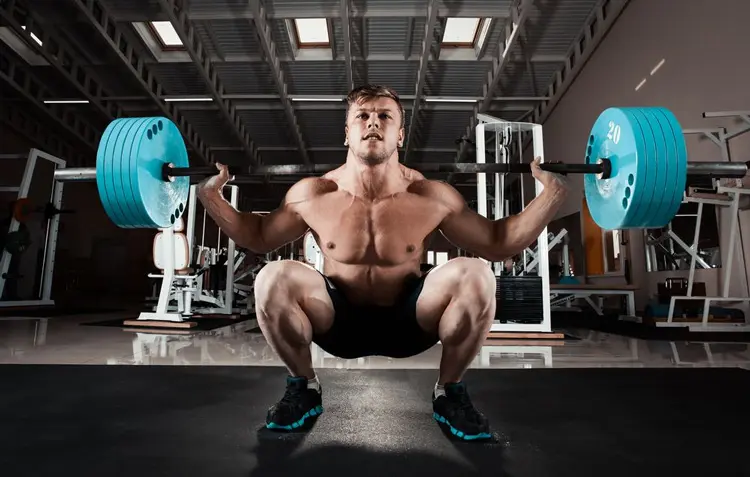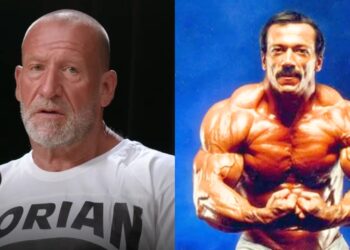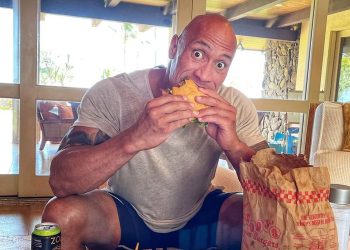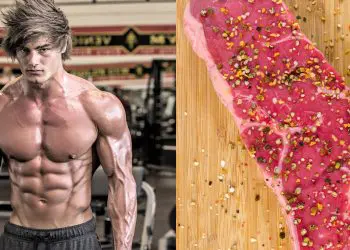If you want to gain muscle fast, bulking is usually the way to go. Bulking involves eating more food than normal which creates a significant calorie surplus. These extra calories fuel your workouts, speed up muscle repair and growth and lead to a noticeable increase in muscle size and body weight.
Bulking is usually combined with heavy strength training and workouts built around the compound lifts, such as the squat, deadlifts, and bench press. So, as you gain muscle and body weight, you’ll also get stronger, too.
Unfortunately, as you gain muscle and strength, during a bulk, you’ll also accumulate body fat. How much depends on the size of your calorie surplus, how long you bulk for, and your basic body type. Endomorphs tend to gain fat faster than ectomorphs and mesomorphs.
Related: Discover your body type here!
Eventually, most lifters either reach their target body weight, build as much muscle as they want, or realize they’ve gained enough fat and need to start getting lean. This means switching from bulking to cutting.
Cutting essentially means losing the layer of fat that obscures your newly built muscle mass.
Level Up Your Fitness: Join our 💪 strong community in Fitness Volt Newsletter. Get daily inspiration, expert-backed workouts, nutrition tips, the latest in strength sports, and the support you need to reach your goals. Subscribe for free!
In this step-by-step guide, we lead you through the process of cutting after bulking.
Muscle Loss: The Problem with Cutting After Bulking
Given a choice between cutting and bulking, most lifters prefer the latter. After all, when bulking, you get to eat lots of high-calorie food, don’t have to worry about hunger, can enjoy a few unhealthy meals and treats, and should feel stronger and more swole.
Cutting invariably means a stricter diet.
This means that some people end up perma-bulking, which is gym-speak for just getting fat! Sure, they lift heavy and look big and muscular but also end up carrying a lot of extra body fat. Not only does this affect how they look, being overfat is terrible for your health, even if you DO work out regularly.
Smart lifters follow a bulk with a period of cutting to shed those extra pounds of fat. The result should be a lean, muscular physique.
However, if you try to cut too aggressively or follow an inappropriate workout routine, you may find yourself losing a lot of muscle as well as fat. After weeks or months of bulking, that really is the last thing you want.
So, the key to a successful cut is to lose fat while preserving as much muscle mass as possible. This can be a tricky process, but if you follow the steps in this guide, your chances of success are a whole lot higher!
Step by Step Guide to Cutting after Bulking
How do you know when it’s time to make the switch from bulking to cutting? It’s really a matter of personal choice, but reasons to start cutting include:
- You’ve reached your target bodyweight
- You’ve reached the end date you set for your bulking diet
- You want to start getting ready for a big event, e.g., beach vacation or wedding
- You’re sick of force-feeding yourself
- You miss seeing your abs!
Whatever the reason, if you want your cut to be successful, following these steps will make the entire process considerably easier.
Step 1 – Pick a start date and set your goal

As mentioned, bulking is invariably more enjoyable than cutting. As such, it’s very tempting to put off cutting for as long as possible. “I’ll start next week” can quickly become “I’ll start next month,” and so on.
Unfortunately, the longer you wait before starting, the longer your cut will need to be, as you’ll have more fat to lose.
Avoid procrastinating by picking a start date to begin cutting. Write it on your calendar and stick to it.
Also, decide how much fat or weight you want to lose. While your target may change up or down, it’s always good to have a goal to work toward. Alternatively, you could pick an end date, such as 12 weeks from now, or the date of the event you want to peak for.
Having a timescale will help focus your mind on what you are going to do.
Step 2 – Determine your TDEE
Cutting means burning fat. To burn fat, you need to create a calorie deficit, and that means providing your body with fewer calories than it needs. Faced with this shortfall in calories, your body has no choice but to start using stored body fat for fuel. If you don’t have a calorie deficit, there is no reason for your body to dip into your fat stores.
While you could just “eat less,” that may not be enough to produce that all-important calorie deficit. You’ll probably get better results if you take a more precise approach.
So, your first step is to work out how many calories you need per day to maintain your current weight. This is called your TDEE, or Total Daily Energy Expenditure. TDEE is made up of three components:
- Basal Metabolic Rate (BMR)– the number of calories you burn per 24 hours at rest
- Thermal Effect of Activity (TEA)– the number of calories you burn during exercise and general physical activity
- Thermal Effect of Food (TEF) – the number of calories used to digest the food you eat
To determine your TDEE, use our online calculator. While not 100% accurate, this will give you a good starting point for calculating how many calories you need to eat per day to burn fat. TDEE calculators take things like your gender, age, and physical activity levels into account to estimate your daily caloric needs.
Step 3 – Create a calorie deficit
If you consume your TDEE in calories, your weight should remain unchanged. After all, your calorie intake should equal your calorie expenditure. So, to shed that unwanted fat, you need to consume fewer calories than your TDEE.
But, while cutting your calorie intake will lead to fat loss, if you are too aggressive, you could end up losing muscle, too, which is something we really want to avoid.
Minimize muscle loss by creating a modest calorie deficit of 300-500 calories per day. This should produce slow but steady fat loss without too much muscle atrophy. Note that this is your starting deficit, and you may need to increase or decrease it based on your progress.
So, starting with your TDEE, subtract 300-500 calories to determine how many calories you need to eat per day. Alternatively, you can use our calorie deficit or weight loss calculator.
Be prepared to redo this calculation every month or so. As you lose weight, your TDEE will decrease, so it’s essential to adjust your calorie intake to avoid fat loss plateaus.
Step 4 – Plan your diet
Failing to plan means planning to fail, or so the old saying goes. Planning your diet will make cutting much easier. If you find yourself feeling hungry and haven’t planned your next meal, you may find yourself cheating on your diet. Planning your meals in advance makes the chances of cheating much lower.
There are lots of diets that can help you cut, including carb cycling, intermittent fasting, and keto. However, it’s important to remember that diets only work if they lead to a calorie deficit.
So, pick your dietary approach and then stick to it, having first ensured that it will put you into a calorie deficit.
Things to look for when choosing a diet include:
Enjoyment – don’t like missing meals? Forget about intermittent fasting. If you don’t like your diet, the chances of sticking to it are slim.
Affordability – can you afford to buy the foods on your diet? Not for a week or a month but for as long as it’s going to take to reach your body composition goal.
Practicality – how easy is it to stick to your chosen diet plan? If it involves making special meals or using exotic ingredients, do you have the means to follow it? Choose a diet that slots seamlessly into your lifestyle to avoid reasons for quitting.
Level Up Your Fitness: Join our 💪 strong community in Fitness Volt Newsletter. Get daily inspiration, expert-backed workouts, nutrition tips, the latest in strength sports, and the support you need to reach your goals. Subscribe for free!
Protein – to preserve muscle mass, you need to consume adequate protein. Low-protein diets are not a good choice for cutting. Most lifters need around one gram of protein per pound of bodyweight, and much less could contribute to muscle loss.
Related: Use Protein Calculator
Health – some diets are better for you than others. Ideally, cutting weight should be a healthy experience. Some diets are decidedly unhealthy and are best avoided. Look for eating plans backed by plenty of research and that have been proven to be safe.
Once you have chosen your diet, start getting ready by buying the foods you’ll need and clearing your kitchen cupboards of the foods that could derail your cut. After all, if you’ve still got a freezer full of ice cream leftover from your bulk, having easy access to it could mean you are more tempted to cheat on your cutting diet.
Step 5 – Track your calories and macros
The best way to make sure you stay true to your diet is to start tracking your calories and macros. While this can be a little time-consuming, it means you are much more likely to hit your daily calorie intake goal and macro targets.
Get into the habit of recording every morsel of food you eat. Do it as you eat, and not after when it’s easy to forget to do it or enter inaccurate data. This will mean weighing or measuring your food. However, this step is very worthwhile as it will ensure you are still producing a calorie deficit.
You should also find that you eat the same foods over and over. Save your favorite foods and meals so you can record them more easily next time. After a couple of weeks, you’ll probably find that recording your food intake takes seconds rather than minutes.
Tracking your calories can also be motivating. As you start to create an unbroken streak of days in calorie deficit, you’ll want to maintain it.
Step 6 – Keep lifting heavy
In the golden era of bodybuilding, a lot of lifters used to follow so-called cutting workouts. This invariably meant switching from heavy compound lifts to lighter, isolation exercises. This approach is NOT recommended for natural lifters.
If you are using steroids, you probably won’t lose much muscle and may even gain some while cutting and lifting light. But, for someone not taking performance-enhancing drugs, such an approach will lead to significant muscle loss.
Your body operates on the principle of “use it or lose it.” So, if you want to maintain your muscle mass, you need to keep challenging your muscles, and the best way to do that is with intense strength training.
High rep, light weight isolation exercises are not as challenging as heavy, compound training. That’s why it’s a mistake to switch to light workouts when you move from bulking to cutting.
Instead, you should endeavor to continue lifting hard and heavy and try to avoid reducing your training weights.
Because you are operating with a calorie deficit, some muscle loss and strength decreases are all but inevitable. However, you can minimize any losses by continuing to train with heavy weights.
Related: How to Burn Fat with Strength Training
Check out our workout library to find a program to use during your next cutting phase!
Step 7 – Do your cardio
If you’ve got a calorie deficit and are hitting the weights hard and heavy, you shouldn’t need to do a lot of cardio to cut. That said, if you want to lose fat faster, cardio can help.
However, if you feel you’ve got to do hours of cardio to burn fat, it could be that you are overeating, and it might be easier just to tighten up on your diet.
Regardless, both Low-Intensity Steady State (LISS) and High-Intensity Interval Training (HIIT) can help you lose fat faster by increasing your calorie expenditure and contributing to your calorie deficit. Take care not to do too much cardio, though, as that could lead to faster muscle loss, especially LISS.
Three or four 20 to 40-minute cardio workouts per week should be enough to help you lose weight faster. Supplement your cardio workouts with plenty of walking, such as 10,000 steps per day. This won’t tire you out, won’t cause muscle atrophy, but will add to your calorie deficit.
Step 8 – Take your supplements
Let’s get one thing straight right now – the only way to get cut and burn fat is to create a calorie deficit by eating less and exercising more. Even the most potent supplements won’t work unless you have a calorie deficit.
Yes, there are some drugs that can cause fat loss, such as clenbuterol, T3, and amphetamines, which pharmaceutically increase your caloric expenditure. Still, the health dangers far outweigh the benefits, and they’re usually illegal, too.
All of that said, there are a few supplements that could help you burn fat and get cut a little faster. Think of these supplements as effort multipliers; the harder you work, the more valuable they become.
Useful options include:
- Whey and plant-based low-calorie protein powder
- Fat burners
- Pre-workouts
- Creatine – especially HCL
- BCAAs
Step 9 – Monitor your progress
Stay motivated and make sure your efforts are paying off by monitoring your progress. After all, you may think you are in a calorie deficit, but that’s not guaranteed. Remember, your TDEE calculation is an estimate, so you’ll need to check your progress to ensure you really are losing fat.
Ways to do this include:
- Waist measurements
- Checking your body fat percentage
- Tracking your bodyweight
- Progress photos
Whichever method you choose, use it regularly and under the same circumstances to ensure you get meaningful results. For example, if you weigh yourself, do so at the same time to avoid weight fluctuations. For photos, use the same camera and lighting.
Step 10 – Make adjustments based on your results
Analyze your progress and adjust your diet and workouts accordingly. If you are losing fat, and your training weights are relatively stable, it’s safe to say you are getting cut without losing muscle. Good job!
But, if you aren’t losing fat or find yourself getting significantly weaker from one week to the next, something is wrong, and you need to make adjustments to continue making progress.
Failing to lose fat means you’re consuming more calories than your TDEE. Tighten up on your diet, increase your calorie deficit, and consider increasing your workouts.
If you are losing a lot of strength, you may be undereating, especially if you are losing more and a couple of pounds per week. Increase your food intake slightly to preserve strength and muscle mass. Make sure you are consuming enough protein. You may also be overtraining, and it might be necessary to cut back on your workout volume and frequency.
Either way, by monitoring your progress, you’ll soon see if you are getting the results you want or need to fine-tune your diet and workout plan to get back on track.
How to Cut After Bulking – Wrapping Up
Even the most successful bulk needs to come to an end eventually. While no one likes cutting, it’s a necessary step if you want to show off your hard-won muscle mass.
That said, a lot of people make a real mess of cutting and end up losing too much muscle along with the fat. Given how hard it is to build muscle in the first place, this really is something best avoided.
So, use the ten steps in this article to shed fat while preserving muscle mass. While this means you’ll probably lose fat a little slower, you’ll end up being lean AND muscular, and not just skinny!

